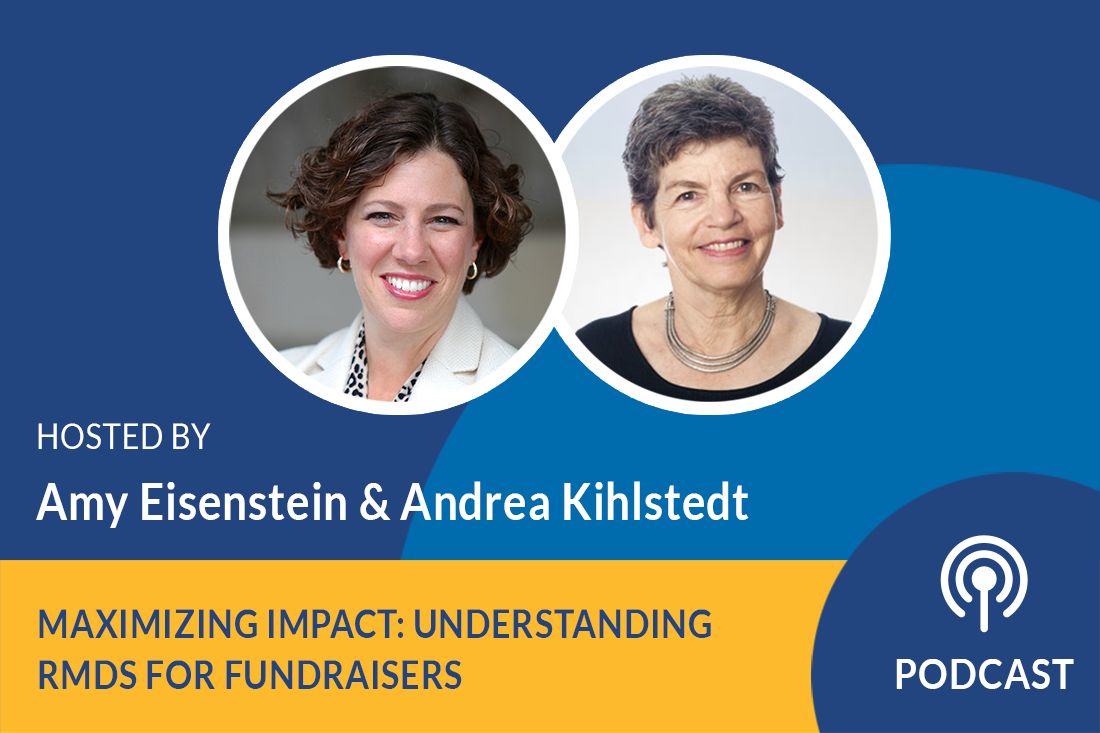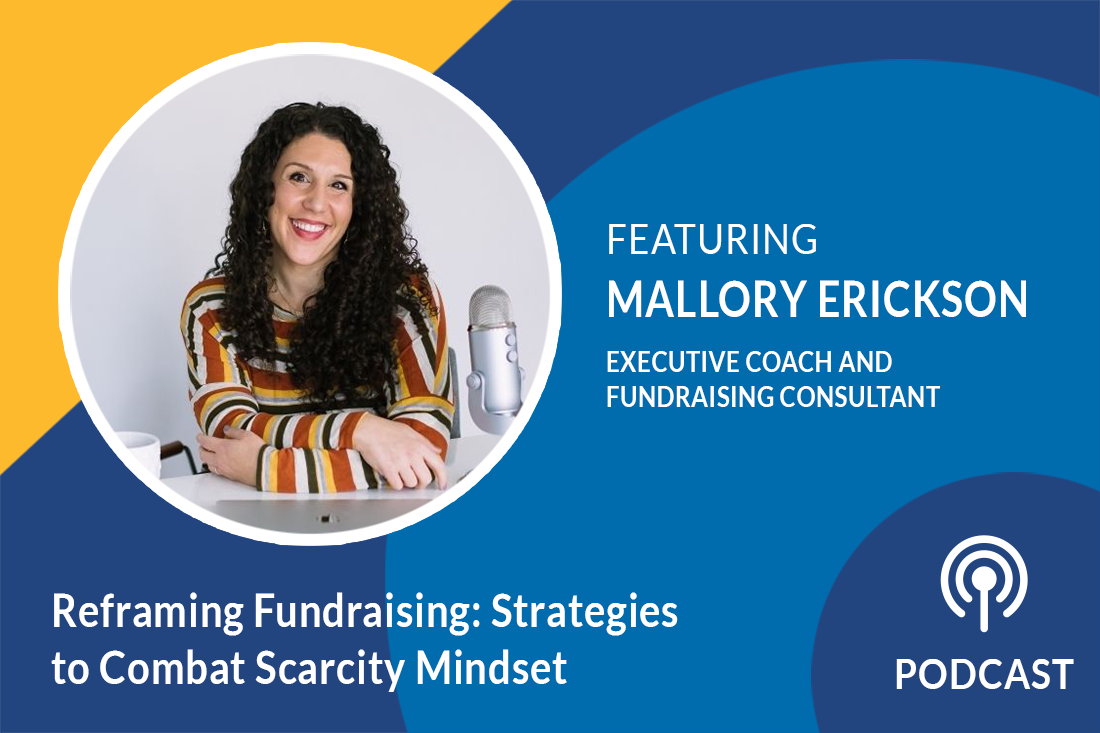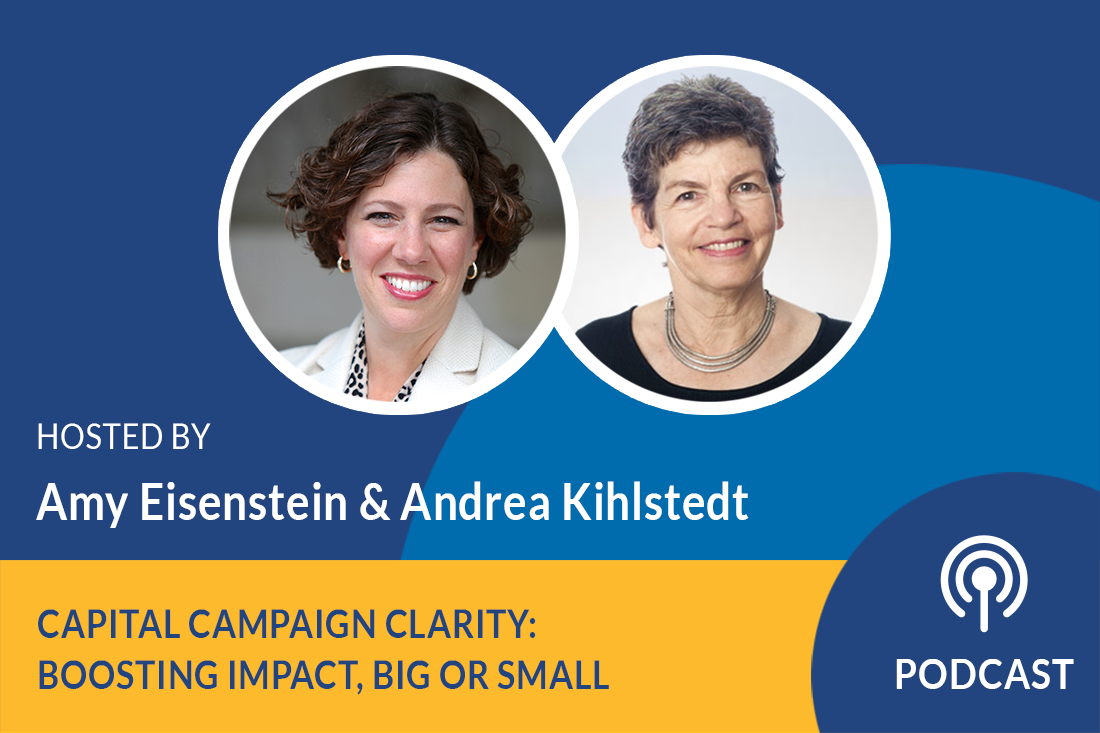Podcast: Maximizing Impact: Understanding RMDs for Fundraisers

Season 3, Episode 56
Join hosts Amy Eisenstein and Andrea Kihlstedt as they unravel the complexities of Required Minimum Distributions (RMDs) in retirement accounts and how they can become a strategic opportunity for philanthropy.
Learn why fundraisers must grasp this concept, empowering them to engage donors effectively and maximize charitable giving potential. Dive into real-life examples and practical insights to navigate RMDs confidently, ensuring donors’ philanthropic goals align seamlessly with their financial planning.
Listen Now:
Amy Eisenstein:
Have you ever heard a donor mention an RMD and wonder what they were talking about? Today, we’re going to hear Andrea’s RMD story.
Hi, I’m Amy Eisenstein. I’m here with my colleague and co-founder Andrea Kihlstedt, and today we are going to talk about RMDs — Required Minimum Distributions.
Required Minimum Distributions (RMDs) for Fundraisers
Andrea, let’s set the stage and talk about what they are and why they’re important, and you can weave in how you learned about them and why they’re important for fundraisers specifically to know about.
Andrea Kihlstedt:
Great. Let me start by, Amy, though by making sure everyone understands that we are not accountants, we are not lawyers, and what we’re going to share with you is not official accounting information or advice —
Amy Eisenstein:
Tax advice.
Andrea Kihlstedt:
… period or tax advice. So you need to do your own homework and your own looking it up. We’re just going to try to help you understand what these things are and why they’re important, specifically from my point of view as an older person who —
Amy Eisenstein:
As a donor.
Andrea Kihlstedt:
As a donor, right.
Amy Eisenstein:
As a donor. But hold on, I’m going to go a step farther in what you just said. Listeners need to have a basic understanding of how this works, and they need to tell every donor that they need to check with their own accountants. The donor’s own accountants.
So fundraisers, we’re not giving tax advice and fundraisers and executive directors and nonprofit leaders should not be giving any tax advice, but having a basic understanding of how things work to have conversations with donors, that’s the important part.
Donors Should Always Be Advised to Consult Their Financial Planners
But regardless of the conversation, donors should be advised to consult with their own financial advisors and accountants prior to making any giving decisions. Okay, that’s the disclaimer.
Andrea Kihlstedt:
But this is a layman’s conversation and let me tell you a little about it.
RMD’s Are Taxed When Withdrawn by their Owners
So my husband and I are both well passed retirement age. He’s in his 80s, I’m in my high 70s. And for many years, we had jobs through which we put money into retirement accounts as you or, you may be doing it now, or some of your donors may have been doing it, in that money when you put money into a retirement account, and there are many different kinds of accounts, but when you put money into a retirement account, for the most part, you take money and the money goes into a retirement account and you don’t pay taxes on that money when you make it. You put it away into an account that is not so the money is not taxed, right? It sits in an investment account of some sort and it grows.
If the money had been taxed before you put it in that account, then you wouldn’t have as much to grow over time. So that’s the great advantage of gradually building a retirement account. The money that goes into a retirement account is pre-tax money. Now the government is perfectly happy to have you do that, but at some point or rather, they want their tax money out of what you’ve saved. They don’t just let you eventually take that money out and spend it. What they say is, “Well, at some point, namely age 72,” Amy and I just looked it up, “at age 72, we the government want to start getting our tax money out of what you have put in that account and deferred.”
So the government says, “All right, starting at age 72, we are going to require that you take a certain percentage of that money every year out of that retirement account. And when you do that, when the money comes to you, when the money comes out of the retirement account to you, you have to pay taxes on it. Then it counts as income.”
Amy Eisenstein:
Yeah. The good news is most people in theory are in a higher tax bracket when they’re working. So if they paid taxes at the beginning, they would’ve been in a higher tax bracket. You’re making a guess that when you’re retired you might be or you’re probably going to be in a lower tax bracket. So it’s win-win all around. I mean, there’s good reasons to do it all around but.
Andrea Kihlstedt:
But mainly you’re investing the money that you would’ve paid in taxes for all those years. And that’s a long time. Let’s say you were 25 or 30 when you started investing in a retirement account. And you’re 72 when you take it out.
Amy Eisenstein:
It’s grown.
Andrea Kihlstedt:
It’s grown. All that money you didn’t pay in taxes during all those years has grown too. So it’s a big deal. That’s actually a big deal.
Why RMD’s Matter for Your Nonprofit
Amy Eisenstein:
Yeah. Let’s get to the Required Minimum Distribution, the RMD. So why should listeners care about all of this mumbo jumbo?
Andrea Kihlstedt:
No, that’s what happens. The government says, “All right, Kihlstedt,” and eventually will say to Amy:
“Okay, Amy, you are old enough that you have to take money out of your retirement account and you have to pay taxes on it when you take it out. We are requiring that you have a minimum distribution. Here’s how much you have to take out.”
Required Minimum Distribution, RMD. It is something that is required by the government and when you take it out, it counts as income and you will pay taxes on it in that calendar year.
Now except — and this is why you need to know about this — except that you can decide that you are going to give away the amount of required money that you have to distribute, required distribution. You can give that away to a nonprofit, a qualified nonprofit organization before you take it out and not pay taxes on it ever.
RMD’s Can be Given as Gifts Avoiding the Tax
So let’s say for the sake of discussion that every month my RMD, my Required Minimum Distribution, is $5,000 a month. Let’s say that the government has said, “All right, over 72,” and it changes every year by the way, that amount. But let’s say that the government is saying I have to take $5,000 a month out of my retirement accounts and I have to pay taxes on them. But if I gave $5,000 a month to my favorite charity instead, guess what? I wouldn’t have to pay taxes on that money, right?
Amy Eisenstein:
Now, listeners may be thinking, “Who on earth doesn’t need that money and can just redirect it to charities?” But people making major gifts and major capital gifts have other sources of income and may not need that money to live as —
Andrea Kihlstedt:
It turns out that there are a lot of people like that because first of all, you’re starting to make social, to draw social security. And if there are two of you in a family and you’re both drawing social security, that’s turns out to be some money. It may well be that you’re no longer paying a mortgage on your house, that your house is paid off. It’s not uncommon for people’s expenses to shrink at this time in life because their kids are off and gone and the expenses you had of educating your kids are no longer the case.
And it may well be that you have other invested income of one sort or another that you’re getting. So it’s not uncommon for people not to need all of that money, in which case they can decide that they’re going to give some of it to your organization. And when they do that, let’s say they’re paying 20% in taxes, it means that they’re going to have 20% more money to give away because they’re not having to pay taxes on the amount of money they’re giving you, which if they withdrew it and paid taxes on it and then paid you, it would amount to less. Does that make sense, Amy?
Amy Eisenstein:
Yes. And we’re just using numbers as examples. Again, none of this is real.
Andrea Kihlstedt:
But the concept is real, right?
Amy Eisenstein:
The concept is real.
Andrea Kihlstedt:
The concept is real, not the numbers.
Amy Eisenstein:
Yes, yes.
Many Older Donors Have RMDs
Andrea Kihlstedt:
Now it turns out that there are a lot of people who are in the donor class, let’s say, who have the ability to give significant amounts of money. And Amy and I, of course, are in a capital campaign business so we’re always looking and interested in people who can give significant amounts of money. And I promise you that just about all of those people have RMDs and probably don’t need all of that money to live on and they’re probably pretty financially savvy.
And they may be saying to you, “Gee, I’m thinking about giving out of my RMD.” And it’s important that you not get this blank stare in your face when they say that to you. You don’t need to know the details of it, but you need to understand what they’re talking about when they say that so that you can say to them, “Great. How is this money going to come? Is there anything we have to do to support that?”
So let me tell you, I just gave a gift like this, and let me tell you how I did it and what I did because it’s probably not uncommon. So I decided that I wanted to give a couple thousand dollars to an organization I support. What I did was I contacted my financial guy. I said to him, “Hey, I want to give $2,000 to such and such an organization out of my RMD. Can you take care of that?” He sent me a form to fill in and that organization is going to get a check from my Schwab account.
Amy Eisenstein:
Excellent. Easy.
Andrea Kihlstedt:
Easy.
Amy Eisenstein:
Yeah.
Andrea Kihlstedt:
And then I emailed the organization, the guy at the organization, and I said:
“Hey Gary, you should know that within a week or so you’re going to get a check from Schwab for $2,000 just in case they forget to put my name on it, a $2,000 check for Schwab. You should know it’s probably from me.”
Amy Eisenstein:
Right, excellent. And I mean, the good news is you’re not even really going to miss the money.
Andrea Kihlstedt:
That’s right.
Amy Eisenstein:
I mean’s it’s sitting in your account.
Andrea Kihlstedt:
That’s right.
Amy Eisenstein:
And it’s an easy thing to give and it adds up. If a donor actually has a required minimum distribution, as in your example of $5,000 and they redirect it to a charity for $60,000 a year for three years, that’s more than $150,000 gift, $180,000 gift. So it’s nothing to sneeze at.
Andrea Kihlstedt:
Yeah. Let’s say if somebody is getting $5,000 a month multiplied times 12, that’s $60,000. They may want to keep half of it or three quarters of it, but some of that they can give to organizations.
Amy Eisenstein:
Yeah.
Andrea Kihlstedt:
Maybe all of it, who knows?
Final Thoughts
Anyway, it’s important that you familiarize yourself with is if what we’ve been talking about sounds like total gobbledygook to you, what you should really do is then to pull one of your older donors aside and you can say:
“Hey, I’m trying to understand this better. Do you have a retirement account from which you have to take a required minimum distribution? And can you explain that to me?”
They’re going to be happy to tell you and it’ll be a good thing. And you can say to them, “Do you ever give out of that?” But have that conversation. Don’t get like a deer in the headlights where those names scare you.
It’s actually a fairly simple concept. And for anyone over 72 with retirement accounts, this is what they have. And many of your larger donors are going to be in that category. So it’s important that you understand this.
Amy Eisenstein:
Right. So next time you’re thinking about asking donors to make a gift, you can say, “Have you ever given a charitable gift out of your retirement accounts? Is that something that might make sense for you?” It can be as simple as that. And then you’re off to the races.
Andrea Kihlstedt:
That’s right. Exactly.
Amy Eisenstein:
Excellent. Well, it’s important that listeners understand different jargon and terminology that their donors may toss out at them and now RMD, they can check off the list.
Andrea Kihlstedt:
Right. I love it.
Amy Eisenstein:
All right. Thanks for listening everyone. We’ll see you next time.



Leave a Comment